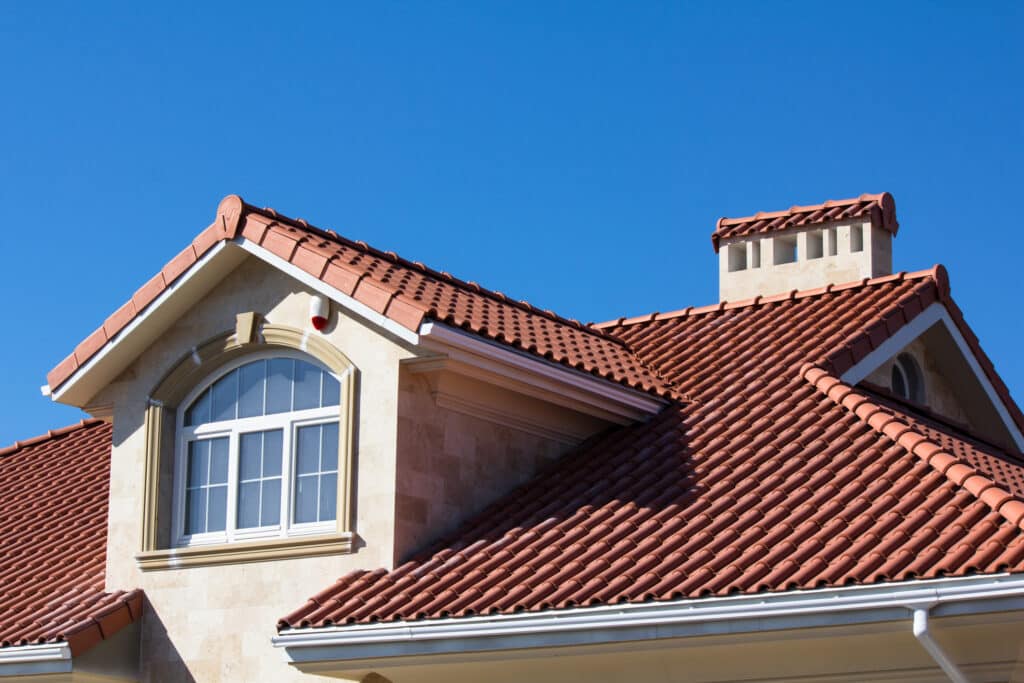Tile roofs are a go-to choice for homeowners in Las Vegas and throughout the Southwest, combining stunning curb appeal with impressive durability. But just how long do tile roofs last? With proper installation and regular care, tile roofs can endure anywhere from 50 to over 100 years — far exceeding many other materials.
In this guide, we’ll break down the tile roof lifespan by material type, examine what really limits longevity (hint: it’s not always the tiles themselves), and provide essential tips for extending the life of a tile roof. Whether you’re evaluating a new installation or caring for an existing roof, this guide will help you grasp the full value of tile roofing.
Why do homeowners and businesses in Las Vegas choose tile roofs?
In Las Vegas, the intense sunlight, arid conditions, and dramatic temperature shifts make durability a top priority for roofing materials. Homeowners and businesses alike choose tile roofs because they provide long-term protection against these elements while offering architectural elegance that suits both modern and Spanish-style homes.
Beyond aesthetics, tile roofing stands up to the local climate better than many alternatives. Tile roofing materials, especially clay tile and concrete tile, are non-combustible, environmentally friendly, and designed to resist heat and water damage. Tile roofs are more than just an appeal enhancer — they’re a strategic, long-lasting roofing material that contributes to cost savings and increased property value.
Tile Roof Lifespan by Material Type
Not all tile roofs are created equal — different materials come with different performance. The average tile roof lifespan varies accordingly:
- Clay tile: 50 to over 100 years.
- Concrete tile: 40 to 75 years.
- Slate tile: 75 to 150+ years.
Each material offers distinct advantages. Clay tiles are known for their superior weather resistance, especially in desert climates. Concrete tiles, while slightly less durable, are more cost-effective and still provide decades of protection, making concrete roof tile one of the most accessible options. Slate tiles offer unmatched longevity and beauty but may be impractical due to weight and cost for many homes.
In Southern Nevada, where temperatures often hit triple digits, a clay tile roof outperforms thanks to its natural resistance to UV damage and thermal expansion. However, a concrete tile roof is also reliable for budget-conscious homeowners seeking a balance of longevity and affordability — concrete tile roof durability is generally strong enough to withstand intense sun and seasonal monsoons when installed correctly. In either case, both materials outperform asphalt shingles.
The Real Lifespan Limiter – Underlayment
While the outer roof tiles may look pristine for decades, the true barrier against water intrusion is the underlayment beneath them. This layer provides waterproof protection and plays a crucial role in preventing mold, leaks, and structural damage. In the desert, underlayment also insulates against heat and protects the roof deck from sun exposure.
The typical tile roof underlayment lifespan is 20 to 30 years, far shorter than the lifespan of the tiles themselves. Homeowners are often surprised to learn that even though their tile roof looks intact, the roof may be vulnerable due to deteriorating underlayment.
Types of underlayment include:
- Asphalt felt: Economical but with a shorter lifespan of around 15–25 years.
- Synthetic underlayment: Popular for its improved durability, typically lasting 25–35 years.
- Rubberized asphalt: Premium choice offering 30–40 years of protection.
Ignoring underlayment replacement puts your home at risk of hidden leaks and mold growth. Conversely, knowing when to replace tile roof underlayment can save you thousands in future repairs.
Factors That Impact Tile Roof Longevity
Even the strongest tile roofs aren’t immune to environmental stressors or installation issues. Several factors can shorten the lifespan of a tile roof:
- Extreme UV radiation causes flashing and sealants to degrade.
- Sudden temperature fluctuations cause expansion and contraction that weakens materials.
- Improper installation compromises waterproofing and tile alignment.
- Foot traffic breaks or loosens tiles.
- Bird droppings contain acids that damage tile surfaces.
- Tree debris and clogged gutters retain moisture that seeps under tiles.
Spotting and mitigating these factors through proper inspection and care can add years — or even decades — to the life of your tile roof.
How does the Las Vegas climate affect roof performance?
Southern Nevada’s desert climate accelerates wear and tear on roofing systems. Monsoon rains and high winds can loosen tiles and damage underlayment, while prolonged dry heat dries out sealants and causes cracking in mortar and flashing.
Regular roof inspection and prompt maintenance are essential to counteract these challenges. A professional tile roof inspection schedule for every 1–2 years is recommended, especially after storms.
How Do Tile Roofs Compare to Other Roofing Materials?
Choosing the right roofing material is about more than cost —longevity, maintenance demands, climate, and home style are all important considerations. Comparing different roofing materials helps narrow down which type will work best for you:
- Tile roofing: Lasts 50–100+ years. Minimal maintenance. High initial cost but superior longevity.
- Asphalt shingles: Last 15–30 years. Prone to weather damage. Frequent replacement needed.
- Flat roofing (TPO, EPDM): Lasts 10–25 years. Lower cost but higher maintenance.
Tile roofs are ideal for long-term homeowners or those investing in higher property values. However, for flat-roofed commercial buildings or budget-conscious homeowners seeking short-term solutions, asphalt shingles or TPO may be more appropriate.
Maintenance Tips to Extend Your Roof’s Life
Routine maintenance is crucial; even durable roofs need consistent care. A few simple preventive steps each year can go a long way in preserving your roof’s durability and appearance
Here are several tile roofing maintenance tips to keep in mind:
- Annual roof inspections: Catch underlayment wear, flashing cracks, or misplaced tiles early
- Gutter cleaning: Prevent water from backing up and penetrating the roof deck
- Tile replacement: Promptly repair any broken tile to avoid moisture entry
- Moss and debris removal: Prioritize shaded areas where moisture can linger
- Avoid walking on tiles: Hire pros when inspections or repairs are needed
These upkeep tasks can dramatically improve tile roof longevity and prevent premature deterioration. Need some extra guidance? Explore more roof maintenance tips to protect your investment.
When and Why to Replace a Tile Roof or Underlayment
Knowing when to act can help you avoid bigger problems down the road. The most pressing signs of tile roof damage include:
- Frequent roof leaks or water stains in the attic.
- Mold growth beneath tiles.
- Broken tile or shifting tiles.
- Sagging roof sections.
- Underlayment older than 20 years.
Should you replace the entire roof or just the underlayment?
If roof tiles are still in good condition, it’s often cost-effective to replace just the underlayment. A professional contractor can lift and reinstall tiles after applying new waterproof layers.
This option saves money and preserves the original look of your clay tiles or concrete tiles. However, if many tiles are cracked or the structure has been compromised, a full roof replacement may be necessary. Understanding your options and acting promptly prevents further structural damage and costly repairs.
Final Thoughts – Is a Tile Roof Right for You?
While the initial cost of tile roofing may be higher than asphalt, the extended lifespan, energy efficiency, and low maintenance make it a solid long-term investment. In Las Vegas, where other materials wear out quickly, tile roofing stands the test of time.
Ultimately, homeowners should consider:
- The weight capacity of their roof structure.
- The condition and type of underlayment used.
- Budget for periodic maintenance and inspections.
- Working with reputable contractors experienced in tile roofing.
Ariat Roofing has decades of experience in tile roof repair, underlayment replacement, and full system installation across Southern Nevada. We understand the local climate and use only top-quality materials designed for longevity.
Ready to extend your roof’s life? Contact our trusted tile roofing contractors in Southern Nevada for a free inspection or estimate today.

